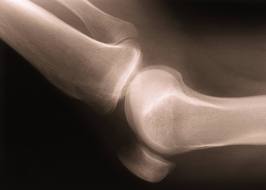Knee pain, instability or loss of motion related to a specific traumatic event.
 Knee Pain Traumatic: Initial Diagnosis and Management
Knee Pain Traumatic: Initial Diagnosis and Management
- History (special attention to mechanism of injury) and physical examination for Knee Pain.
- Radiographs to rule out fractures.
- Obvious fracture, instability, or motor disruption: refer (see below).
- Initial exam may be difficult due to Knee pain and/or significant effusion.
- In these cases, treat w/ice and compression for 4-14 days and re-assess.
- Exercises should be initiated immediately to prevent loss of muscle tone and bulk (*consult PT for instruction and/or supervision of exercises).
Knee Pain Traumatic: Ongoing Management and Objectives
- Repeat examination at 4 to 14 days for more definitive physical evaluation of Knee Pain.
- Medial or lateral collateral ligament strains (w/o instability): treat with bracing, activity limitations and appropriate knee rehabilitation exercises. Treat for 6-8 weeks.
- MRI if effusion or other symptoms persist beyond 6-8 weeks.
Knee Pain Traumatic: Indication a profile is needed
- Any limitations that affect strength, range of movement, and efficiency of feet, legs, lower back and pelvic girdle.
- Slightly limited mobility of joints, muscular weakness, or other musculo-skeletal defects that may prevent moderate marching, climbing, timed walking, or prolonged effect.
- Defects or impairments that require significant restriction of use.
Knee Pain Traumatic: Specifications for the profile
- Months 1-3
- No running, jumping, marching, squatting.
- Months 4-6
- Gradual transition into own pace and distance
